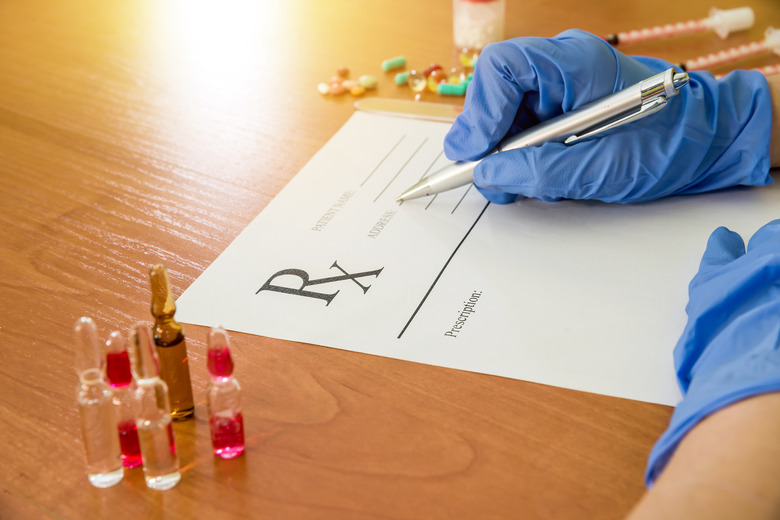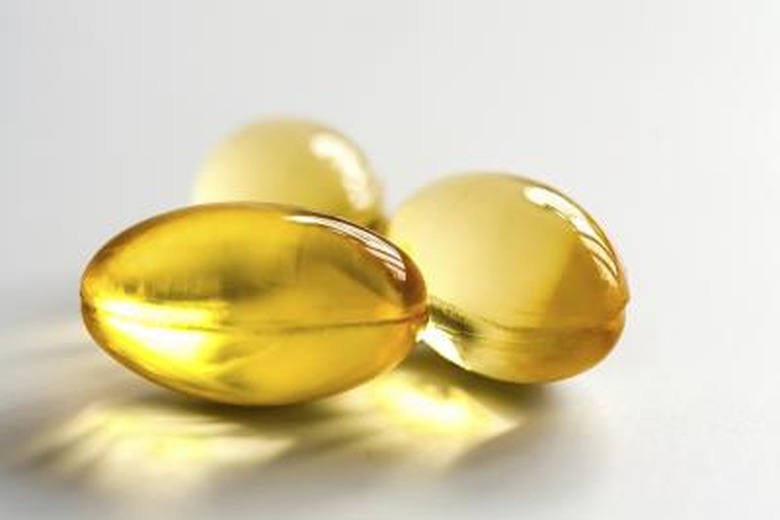How To Convert Between IU & MG And MCG
The human body requires a variety of vitamins to function. A healthy diet provides most vitamins that people need. When diet alone doesn't offer enough nutrients, taking vitamin supplements helps to fill in for dietary shortcomings. Because supplements are not standardized and regulated as stringently as pharmaceuticals, it can be difficult to determine the amount of a substance in a specific preparation and to know an acceptable dosage. Vitamin supplements may be measured in milligrams, micrograms or international units. Converting between these units can help clarify the amount of vitamin needed.
Milligrams and Micrograms
Milligrams and Micrograms
The organization of the metric system makes conversion between units convenient by multiplying or dividing by multiples of 10. On the metric scale of prefixes, milli- equals 1/1000 and micro- equals 1/1,000,000. If the unit is grams, which measures the mass of a substance, then one gram contains 1,000 milligrams or 1,000,000 micrograms. To convert from milligrams to micrograms, multiply by 1,000. To convert from micrograms to milligrams, divide by 1,000. For example, 100 mg of vitamin C equals 100,000 mcg, or µg.
International Units
International Units
Milligrams and micrograms indicate the amount of mass in a sample, but international units indicate the level of biological activity of a substance. One international unit, or IU, is a measurement of the biological effect that a specific substance has on the body. International agreement among various scientific organizations determined the IU value for specific formulations of vitamins. For each type of vitamin preparation, there is a unique IU value based on the method used for formulating that vitamin.
Water-Soluble Vitamins
Water-Soluble Vitamins
The eight B-complex vitamins and vitamin C are water soluble. The polarity of these molecules allows them to dissolve in water or water-based solvents. Because these vitamins are soluble in water, they can be easily excreted from the body in urine. There is little danger of a build-up of excess amounts of water-soluble vitamins in the body. The downside of water solubility is the need to constantly replace the vitamins either by eating foods rich in these nutrients or taking vitamin supplements.
Fat-Soluble Vitamins
Fat-Soluble Vitamins
Fat -soluble molecules are non-polar and cannot be dissolved in water. They include vitamins A, D, E and K. Fat-soluble vitamins are stored in the liver and adipose tissue, and the body eliminates these vitamins more slowly than water-soluble vitamins. Because they are stored for long periods of time, these vitamins can accumulate in the body. Taking excessive dosages of fat-soluble vitamins can have a toxic effect because they linger in the body for longer periods of time and cannot easily be purged. The dosages for vitamins A, D and E are given in IU but may also be presented in mg or µg.
Recommended Dietary Allowance
Recommended Dietary Allowance
Supplement labels provide a recommended dietary allowance (RDA) to inform consumers of the average amount of a specific vitamin they should consume daily. The RDA varies according to age and gender because each stage of life and gender has its own nutritional requirements. Unless otherwise specified, the RDA on a supplement label refers to both genders older than four years.
Examples
Examples
**Vitamin A:** There are two widely available preparations of vitamin A: retinol and beta carotene. The IU equivalent of vitamin A in the retinol format is 0.3 µg per 1 IU. The value for beta carotene is 0.6 µg per IU. If the RDA for vitamin A as a retinol preparation is 3,000 IU, the equivalent in micrograms is 900 µg. Converted to milligrams, this amount equals 0.9 mg.
**Vitamin E:** Vitamin E is available in two formats: d-alpha-tocopherol, a natural source, and dl-alpha-tocopherol, a synthetic source. One IU of d-alpha-tocopherol equals 0.67 mg. Converted to micrograms, it equals 670 µg. The dl-alpha-tocopherol formulation contains 0.9 mg vitamin E per IU. In micrograms that is equivalent to 900 µg. The RDA for an adult is 22.4 IU of the natural version and 33.3 IU of the synthetic version, or about 15 mg and 30 mg.
**Vitamin D:** The most commonly available vitamin D preparation is vitamin D3, or cholecalciferol. 40 IU of vitamin D equals 1 µg, which can be converted to 0.001 mg. The RDA for an adult ranges from 600-800 IU. In micrograms, that would be 15 to 20 µg. Using milligrams changes the value range to 0.015-0.020 mg.
Cite This Article
MLA
Mentzer, A.P.. "How To Convert Between IU & MG And MCG" sciencing.com, https://www.sciencing.com/convert-between-iu-mg-mcg-8298314/. 26 April 2018.
APA
Mentzer, A.P.. (2018, April 26). How To Convert Between IU & MG And MCG. sciencing.com. Retrieved from https://www.sciencing.com/convert-between-iu-mg-mcg-8298314/
Chicago
Mentzer, A.P.. How To Convert Between IU & MG And MCG last modified March 24, 2022. https://www.sciencing.com/convert-between-iu-mg-mcg-8298314/


